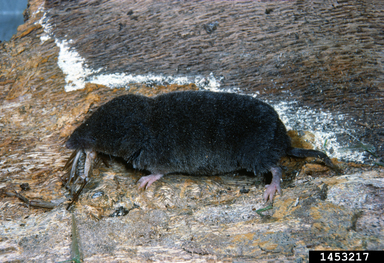Bob Suchanek, Waters and Wetlands Steward

Blarina brevicauda – The Short-Tail Shrew
Photo credit: Sturgis McKeever, Georgia Southern University, Bugwood.org
Shrew Déjà Vu
A stroll around the lake often includes surprises, none less expected than a beady eyed, pointy nosed short-tail shrew fretting it's way along the side of the path. It's been a long time since my first encounter with these little insect eaters and never have they been so unconcerned with my presence.
When I was a biology student, my professor assigned a springtime field study project. We were to trap mice and other small mammals and write a paper about them. I've forgotten many of the details but I do remember that the traps were small, simple wire boxes with a door that closed and trapped the animals inside while they enjoyed a free seed meal. We wore gloves and took turns checking the traps, marking the captives, noting the species, and resetting the traps.
I also remember that short-tail shrews were frequent diners that spring.
Venomous - Handle With Care
The bite of a short-tail shrew injects a toxic venom (blarina toxin) into its prey. When I was tending the mammal trapline only a few venomous mammals were known (including the duck-billed platypus) so having one in hand seemed like a privilege (and a good incentive for wearing gloves). Today, over a dozen venomous species have been recognized worldwide, but I still feel excited and a bit intimidated in the presence of our Minnesota example. The short-tail shrew's bite is fatal to small animals. Shrew-bitten humans will be sore if stung, and sorry that they weren't more careful.
“If I be waspish, best beware my sting.” - William Shakespeare, The Taming of the Shrew
Shrewd Living
The short-tail shrew is one of a half dozen shrew species in Minnesota but it's the only venomous member of that bunch. Shrews will eat seeds, worms, and other shrews but they prefer a diet of
insects. When I think of shrews in general I think of tiny high performance athletes, daily consuming up to three times their weight in food.
Unlike athletes, none are very big; the short-tail shrew is Minnesota's biggest shrew weighing in at one-half to three-fourths of an ounce. The pygmy shrew is Minnesota's smallest shrew at around one-eighth of an ounce.
Shrews aren't rodents so they shouldn't be called mice; they're more closely related to moles and have similar dietary preferences. Referring to shrews as insectivores (insect eaters) is appropriate. Look for them almost anywhere. I trapped shrews in a partially wooded area well away from water but I'm seeing them lately near paths around local lakes and wetlands.
Some sources:
https://www.dnr.state.mn.us/mammals/shrews.html
https://a-z-animals.com/blog/the-worlds-10-most-venomous-mammals/